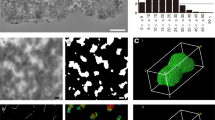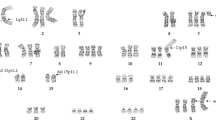Abstract
AFTER the introduction of the quinacrine fluorescence method1, several Giemsa staining techniques have been developed for karyotype analysis of human chromosomes. Pardue and Gall2, originally noticed a denser staining of centromeric regions of chromosomes after in situ hybridisation of mouse chromosome preparations with mouse satellite DNA followed by Giemsa staining. This initial approach was modified by Arrighi and Hsu3 who omitted DNA hybridisation. Later, Sumner et al.4 left out treatment with RNase and HC1 as well. Finally, McKenzie and Lubs5 treated chromosomes with HCl and 2×SSC only. These modified Giemsa procedures all produce densely stained regions of one or both chromosome arms close to the centromere. These C-band procedures also stain the secondary constriction of chromosome 1, 9 and 16, as well as the distal part of the Y chromosome. Satellites that stain brightly by Q-band techniques are also revealed by these methods.
This is a preview of subscription content, access via your institution
Access options
Subscribe to this journal
Receive 51 print issues and online access
$199.00 per year
only $3.90 per issue
Buy this article
- Purchase on Springer Link
- Instant access to full article PDF
Prices may be subject to local taxes which are calculated during checkout
Similar content being viewed by others
References
Caspersson, T., Zech, L., Modest, E. J., Foley, G. E., Wagh, U., and Simonsson, E., Expl. Cell Res., 58, 128 (1969).
Pardue, M. L., and Gall, J. G., Science, N.Y., 168, 1356 (1970).
Arrighi, F. E., and Hsu, T. C., Cytogenetics, 10, 81 (1971).
Sumner, A. T., Evans, H. J., and Buckland, R. A., Nature new Biol., 232, 31 (1971).
McKenzie, W. H., and Lubs, H. A., Chromosoma, 41, 175 (1973).
Chen, T. R., and Ruddle, F. H., Chromosoma, 34, 51 (1971).
Gagné, R., and Laberge, C., Expl. Cell Res., 73, 239 (1972).
Bobrow, M., Madan, K., and Pearson, P. L., Nature new Biol., 238, 122 (1972).
Eiberg, H., Clin. Genet., 4, 556 (1973).
Saunders, G. F., Hsu, T. C., Getz, M. J., Simes, E. L., and Arrighi, F. E., Nature new Biol., 236, 244 (1972).
Author information
Authors and Affiliations
Rights and permissions
About this article
Cite this article
EIBERG, H. New selective Giemsa technique for human chromosomes, Cd staining. Nature 248, 55 (1974). https://doi.org/10.1038/248055a0
Received:
Published:
Issue Date:
DOI: https://doi.org/10.1038/248055a0
This article is cited by
-
Ultrastructural detection of kinetochores by silver impregnation
Chromosome Research (1994)
-
Interstitial deletions of repetitive DNA blocks in dicentric human Y chromosomes
Chromosoma (1994)
-
Centromeric dots in crane-fly spermatocytes: meiotic maturation and malorientation
Chromosoma (1989)
-
Kinetochore development in two dicentric chromosomes in man
Human Genetics (1989)
-
C-anaphases in lymphocyte cultures versus premature centromere division syndromes
Human Genetics (1988)
Comments
By submitting a comment you agree to abide by our Terms and Community Guidelines. If you find something abusive or that does not comply with our terms or guidelines please flag it as inappropriate.



